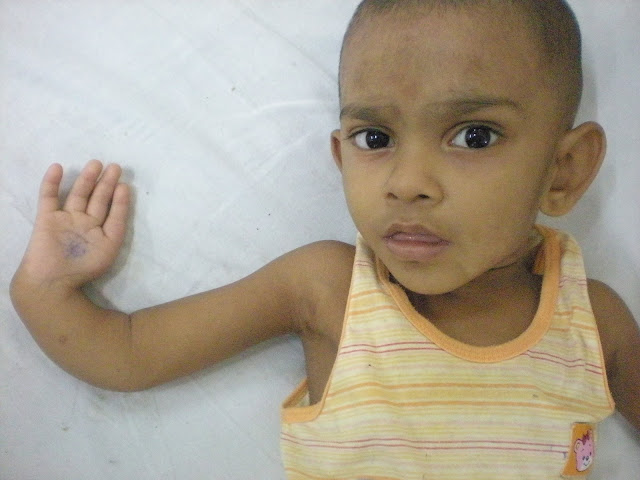Question: Name the syndrome and congenital anomalies associated with this syndrome?
Answer: Holt-Oram syndrome. Absent thumb with congenital heart disease.
Background
Holt-Oram syndrome (heart-hand syndrome) is an autosomal dominant inherited disorder characterized by abnormalities of the upper limbs and heart (ASD, VSD). Holt and Oram first described this condition in 1960 in a 4-generation family with atrial septal defects and thumb abnormalities.
Pathophysiology
The syndrome is inherited as an autosomal dominant trait that is completely penetrant. The disease is due to mutations in the transcription factor TBX5, which is important in the development of both the heart and upper limbs.
Upper limb involvement
Although the clinical manifestations are variable, upper limb abnormalities are always present. Abnormalities may be unilateral or bilateral and asymmetric and may involve the radial, carpal, and thenar bones. Aplasia, hypoplasia, fusion, or anomalous development of these bones produces a spectrum of phenotypes, including triphalangeal or absent thumbs. Occasionally, upper limb malformation can be sufficiently severe to produce phocomelia (a malformation in which the hands are attached close to the body); this has been termed pseudothalidomide syndrome.
Cardiac involvement
Approximately 75% of patients have some cardiac abnormality. In most patients, the abnormality is either an atrial septal defect (ASD) or a ventricular septal defect(VSD), progressive atrioventricular block and atrial fibrillation.
Holt-Oram syndrome is the most common form of heart-hand syndrome, with prevalence estimated at 0.95 cases per 100,000 total births.
Mortality/Morbidity
- Significant intracardiac shunts can be associated with sudden death or the development of pulmonary hypertension and Eisenmenger syndrome.
- The first clinical manifestation of the disease may be heart failure, cardiac arrhythmias (including heart block), or infective endocarditis.
- Considerable physical and psychologic morbidity may be associated with limb abnormalities, particularly in severe cases.
Age
- A congenital disease, Holt-Oram syndrome is present at birth. Subtle limb involvement may not become clinically apparent until later in life when the cardiac symptoms of the disease manifest or when an individual has a child with a more severe presentation of the syndrome.
- Cardiac conduction disease is progressive with aging.
- Middle-aged individuals often present with significant atrioventricular block or atrial fibrillation.
Clinical
- Patients may have a family history of cardiac and/or limb malformation.
- Patients may present in infancy with obvious limb malformations and/or signs of cardiac failure secondary to ASD, VSD, or cardiac conduction disease.
- Upper limb deformity
- Always present but may be unilateral or bilateral
- Left-sided abnormalities often more severe than right arm or hand abnormalities
- Unequal arm lengths due to aplasia, hypoplasia, fusion, or anomalous development of the radial, carpal, and thenar bones
- Abnormal forearm pronation and supination
- Triphalangeal or absent thumbs
- Possible abnormal opposition of thumb
- Possible sloping shoulders and restriction of shoulder joint movement
- Phocomelia
- Cardiac involvement
- Bradycardia
- Irregular pulse (ectopy)
- Irregular pulse that occurs irregularly (atrial fibrillation)
- Wide, fixed splitting of the second heart sound
- Pulmonary systolic flow murmur
- Holosystolic murmur (should raise consideration for a VSD)
- Anomalies involving any of the following are indicators that a diagnosis of Holt-Oram syndrome can be excluded:
- Ulnar bone
- Lower limbs
- Kidneys
- Eyes
- Auditory
- Craniofacial
- Vertebrae (may or may not occur in Holt-Oram syndrome)
Causes
- Molecular genetic studies reveal that the disease is caused by mutations that inactivate the transcription factor TBX5 on long arm of chromosome 12. This genetic disorder that is autosomal dominant and highly penetrant.
Congenital Malformation Syndromes Associated with Congenital Heart Disease
| SYNDROME | FEATURES |
| CHROMOSOMAL DISORDERS | |
| Trisomy 21 (Down syndrome) | Endocardial cushion defect, VSD, ASD |
| XO (Turner syndrome) | Bicuspid aortic valve, coarctation of aorta |
| Fragile X | Mitral valve prolapse, aortic root dilatation |
| Deletion 5p (cri du chat syndrome) | VSD, PDA, ASD |
| SYNDROME COMPLEXES | |
| CHARGE association (coloboma, heart, atresia choanae, retardation, genital and ear anomalies) | VSD, ASD, PDA, TOF, endocardial cushion defect |
| DiGeorge sequence, CATCH 22 (cardiac defects, abnormal facies, thymic aplasia, cleft palate, and hypocalcemia) | Aortic arch anomalies, conotruncal anomalies |
| Alagille syndrome (arteriohepatic dysplasia) | Peripheral pulmonic stenosis |
| VATER association (vertebral, anal, tracheo esophageal, radial, and renal anomalies) | VSD, TOF, ASD, PDA |
| PHACE syndrome (posterior brain fossa anomalies, facial hemangiomas, arterial anomalies, cardiac anomalies and aortic coarctation, eye anomalies) | VSD, PDA, coarctation of aorta, arterial aneurysms |
| TERATOGENIC AGENTS | |
| Congenital rubella | PDA, peripheral pulmonic stenosis |
| Fetal hydantoin syndrome | VSD, ASD, coarctation of aorta, PDA |
| Fetal alcohol syndrome | ASD, VSD |
| Fetal valproate effects | Coarctation of aorta, hypoplastic left side of heart, aortic stenosis, pulmonary atresia, VSD |
| Maternal phenylketonuria | VSD, ASD, PDA, coarctation of aorta |
| Retinoic acid embryopathy | Conotruncal anomalies |
| OTHERS | |
| Apert syndrome | VSD |
| Autosomal dominant polycystic kidney disease | Mitral valve prolapse |
| Carpenter syndrome | PDA |
| Conradi syndrome | VSD, PDA |
| Crouzon disease | PDA, coarctation of aorta |
| Cutis laxa | Pulmonary hypertension, pulmonic stenosis |
| de Lange syndrome | VSD |
| Ellis-van Creveld syndrome | Single atrium, VSD |
| Holt-Oram syndrome | ASD, VSD, 1st-degree heart block |
| Infant of diabetic mother | Hypertrophic cardiomyopathy, VSD, conotruncal anomalies |
| Noonan syndrome | Pulmonic stenosis, ASD, cardiomyopathy |
| TAR syndrome (thrombocytopenia and absent radius) | ASD, TOF |
| Treacher Collins syndrome | VSD, ASD, PDA |
| Williams syndrome | Supravalvular aortic stenosis, peripheral pulmonic stenosis |
